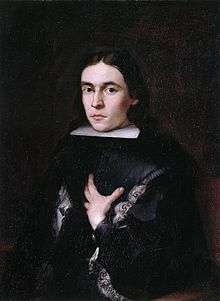Fernando de Valenzuela, 1st Marquis of Villasierra

Fernando de Valenzuela, 1st Marquis of Villasierra, Grandee of Spain, (in full, Spanish: Don Fernando de Valenzuela y Enciso, Núñez y Dávila, primer marqués de Villasierra, Grande de España, Virrey de Granada), (8 January 1630, Naples – 7 February 1692) was a Spanish royal favourite and minister.[1]
Early life
His father, Francisco de Valenzuela, was a gentleman from Ronda who had been compelled to flee from Spain as a consequence of a brawl, and who enlisted as a soldier in Naples, where he married Leonora de Encisa. Francisco having died young, his son was placed by his mother as a page in the household of the Duke of Infantado. He lost his place owing to a reduction of the Duke's establishment, and for several years he lived obscurely. By good fortune he succeeded in persuading Maria de Uceda, one of the ladies-in-waiting to Queen Mariana of Austria, second wife of Philip IV, to marry him.[1]
Royal favourite

With the help of his wife, Valenzuela obtained a footing in the palace. He was appointed introducer of ambassadors on 12 October 1671, and it became notorious that whoever had a petition to present or a place to ask for must apply to him. He became popularly known as the duende, the "fairy" or "brownie" of the palace, and was believed to be the lover of the queen. He was considered as successor of the previous valido, Juan Everardo Nithard.[1]
In 1675 a court intrigue, conducted by his rivals and supported by Don John of Austria the Younger, was so far successful that he was driven from court; but the queen gave him the title of Marquis of Villasierra and appointed him ambassador to Venice.[1]
Valenzuela succeeded in getting the embassy exchanged for the governorship of Granada. His stay at this post was short, for he was able to organize a counter-intrigue which soon brought him back to court. The queen-regent now openly appointed him prime minister, gave him official quarters in the palace, and conferred a grandeeship on him, to the profound indignation of the other grandees.[1]
In January 1677 a palace revolution broke out against the queen-regent, who was driven from Madrid, and Valenzuela fled for refuge to the monastery of El Escorial. He was, however, taken out by force, and his house was pillaged and his property confiscated. His jewels, furniture and ready money were estimated to amount to 120,000 pesos. He was degraded from the grandeeship and exiled to the Philippines.[1]
Later life
At a later period he was released from close confinement and allowed to settle in Mexico, where a pension was given him. He died in Mexico, from the kick of a horse he was breaking in, on February 7, 1692. Part of his property, and the title of Villa Sierra, but not the grandeeship, were restored to his wife and children. The career of de Valenzuela probably helped to suggest the subject of Ruy Blas to Victor Hugo.[1]
Notes
References

- Hobbs, Nicolas (2007). "Grandes de España" (in Spanish). Retrieved 15 October 2008.
- Instituto de Salazar y Castro. Elenco de Grandezas y Titulos Nobiliarios Españoles (in Spanish). periodic publication.
| Spanish nobility | ||
|---|---|---|
| New title | Marquis of Villasierra 1676-1692 |
Succeeded by |